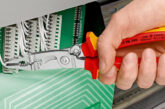
The experts at Electrium look at the considerations professionals must be aware of when replacing a new consumer unit, in line with Amendment 2 to the 18th Edition.
Replacing a consumer unit is classed as an alteration to the electrical installation. Alterations and additions are categorised as ‘new work’ and all new work on an electrical installation must be designed, installed, and verified in accordance with the current edition of BS 7671 (designers and installers should refer to BS 7671 and other relevant documents for full requirements). The current edition is BS 7671 2018 including Amendment 2.
Scope of new work
In some circumstances the scope of the new work for such a task may be limited to the installation of a new consumer unit and new circuit protection devices. However, it may be necessary to carry out other new work in order to meet all of the required safety levels, especially if C1 conditions have been observed from an inspection of the installation.
New consumer unit and devices
In situations that require a consumer unit to be replaced the new consumer unit should comply with BS EN 61439-3 and Regulation 421.1.201 which requires the consumer unit to have its enclosure manufactured from non-combustible material or be enclosed in a cabinet made of non-combustible material.
Consumer units that meet the above criteria are designed to incorporate protective devices such as MCBs, RCBOs, AFDDs, and SPDs that the wiring regulations require. These devices provide much higher levels of protection and electrical safety than old fashioned fuses ever could.
Existing circuits and BS 7671
Where the existing wiring is deemed to be suitable to be connected to the new consumer unit there are some specific requirements within the Wiring Regulations that will determine which type of protective device is required on each circuit.
Additional protection by use of 30mA RCD is required on cables buried/concealed in walls and partitions if those cables aren’t installed in/with earthed metallic coverings. Therefore, where the existing final circuits are installed in this way additional protection by a 30mA RCD is required (see Regulations 522.6.202, 522.6.203 & 522.6.204).
Additional protection by use of 30mA RCD is required for each circuit that passes through or serves equipment in locations containing a bath or shower (see Regulation 701.411.3.3).
Additional protection by use of a 30mA RCD is required for users of socket outlets (up to 32A rating) in all locations where they’re liable to be used by persons of BA1, BA2 & BA3 capability i.e. ordinary persons, children, and disabled persons. No exceptions are permitted (see Regulation 411.3.3).
AFDDs are required for single-phase AC final circuits supplying socket-outlets (up to 32A rating) in high risk residential buildings, homes in multiple occupation, care homes and student accommodation (see Regulation 421.1.7). Note: Electrium AFDDs include an integral Type A 30mA RCBO and can provide additional protection as well as arc fault protection.
SPDs should be installed in new consumer units unless the owner of the installation declares otherwise. An owner who declares that overvoltage protection is not required accepts all risks, consequences, and losses (see Regulation 443.4.1).
Other considerations also apply
Catering for modern demands on an electrical installation means taking account of the connected equipment, and portable devices. These will no doubt bring DC influences and PE currents into consideration for the installer.
For example, Regulation 531.3.2 requires protective conductor currents (standing earth leakage not due to a fault) to be no more than 9mA for a 30mA device to help to avoid unwanted tripping, but that can’t be achieved if several circuits are protected by one RCD device.
There are also the requirements of Chapter 31 and Regulation 314.1 to consider. This requires the installer to:
● reduce the possibility of unwanted tripping of RCDs,
● avoid danger and minimize inconvenience in the event of a single fault,
● take account of hazards that may arise from the failure of a single circuit,
● facilitate safe inspection, testing and maintenance.
Therefore, wherever additional protection by a 30mA device is required each circuit should be served by an individual Type A 30mA RCBO to fully meet the requirements of the current edition of the Wiring Regulations.
Verification
New work, such as the replacement of a consumer unit and associated devices, should be verified in accordance with the requirements of Chapter 64 of the Wiring Regulations and the relevant electrical installation certificate should be given to the person ordering the work (see Regulations 641.1, 644.1 and 644.3).
Get more 18th Edition technical support and advice from Electrium here








